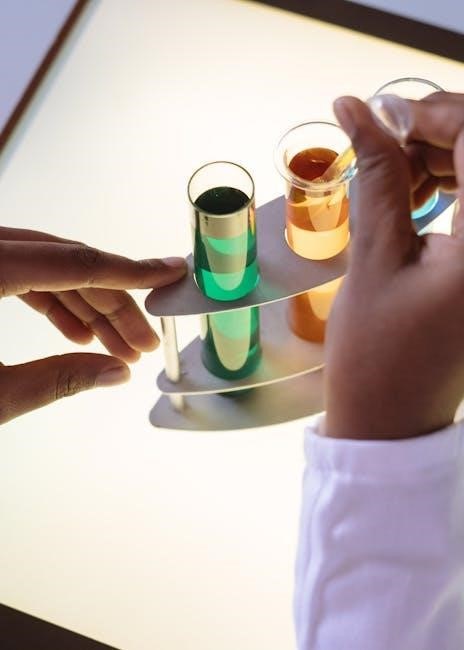The Pglo Transformation Lab introduces students to genetic engineering basics, focusing on bacterial transformation with the pGLO plasmid․ This hands-on experiment demonstrates gene expression and bioluminescence principles, allowing visualization of transformation success through GFP fluorescence under UV light․
Overview of the Pglo Transformation Lab
The Pglo Transformation Lab is a foundational genetic engineering experiment where students transform E․ coli bacteria with the pGLO plasmid․ This plasmid contains the GFP gene, enabling bacteria to fluoresce under UV light․ The lab involves preparing bacterial cells, performing transformation, and observing results on selective plates․ It teaches key concepts like gene expression, bacterial transformation, and the role of plasmids in genetic engineering․ This hands-on activity provides a clear visual confirmation of successful transformation, making it an engaging tool for understanding molecular biology principles․
Purpose and Importance of the Lab
The Pglo Transformation Lab is designed to teach fundamental genetic engineering concepts, such as bacterial transformation and gene expression․ Its primary purpose is to allow students to observe the successful uptake of the pGLO plasmid by E; coli, visualized through GFP fluorescence․ This lab is crucial for understanding how genes can be introduced into organisms and expressed, making it a cornerstone of biotechnology education․ It also emphasizes the importance of aseptic techniques and the role of selectable markers in genetic experiments, providing practical skills in molecular biology․
The pGLO plasmid is a circular DNA molecule designed for bacterial transformation experiments․ It contains the gene for Green Fluorescent Protein (GFP), which glows under UV light when expressed․ The plasmid also includes an ampicillin resistance gene, allowing selection of transformed bacteria․ GFP serves as a reporter gene, confirming successful transformation․ The gene is under the control of an arabinose-inducible promoter, enabling regulated expression․ This system provides a visual and selectable marker for identifying bacteria that have successfully taken up the plasmid, making it a powerful tool in genetic engineering education․
Lab Setup and Materials
The Pglo Transformation Lab requires specific materials, including LB agar plates, ampicillin, arabinose, and the pGLO plasmid․ These components ensure proper bacterial growth and transformation conditions․
Materials Required for the Experiment
The Pglo Transformation Lab requires specific materials, including LB agar plates with ampicillin, arabinose, and the pGLO plasmid․ Additional items like microcentrifuge tubes, gloves, and UV light are essential․ These components ensure proper bacterial growth, transformation, and gene expression visualization․ Sterile equipment and solutions are critical to prevent contamination and maintain experiment integrity․
Lab Setup and Preparations
Setting up the Pglo Transformation Lab involves preparing LB agar plates with ampicillin and arabinose․ Ensure all materials are sterilized, and bacterial cultures are grown in a controlled environment․ Autoclave equipment and solutions to maintain sterility․ Label plates clearly and store them at 4°C until use․ Prepare transformation solutions like calcium chloride and chill competent cells on ice․ Organize microcentrifuge tubes and UV light for post-transformation analysis․ Proper setup ensures efficient bacterial growth and accurate observation of GFP expression․
Understanding the Role of Different Plates
In the Pglo Transformation Lab, several types of plates are used to facilitate bacterial growth and transformation․ LB agar plates with ampicillin (LB/amp) select for bacteria that have successfully taken up the pGLO plasmid, as only transformed cells can grow in its presence․ Plates with arabinose (LB/amp/ara) induce GFP expression, allowing visualization of successful transformation under UV light․ Control plates without ampicillin or arabinose help verify the transformation process and ensure experimental validity by comparing growth patterns and fluorescence․

Procedure of the Pglo Transformation Lab
The procedure involves preparing competent bacterial cells, adding the pGLO plasmid, and applying heat shock to facilitate transformation․ Transformed cells are then incubated and plated on selective media to observe successful gene uptake and expression․
Preparation of Bacterial Cells
Bacterial cells are prepared for transformation by growing them in a nutrient-rich environment to ensure they are healthy and actively dividing․ They are then treated with calcium chloride to make their cell membranes permeable, allowing the plasmid DNA to enter․ The cells are incubated on ice to maximize DNA uptake before a brief heat shock to facilitate plasmid integration․ Properly prepared competent cells are crucial for successful transformation and subsequent gene expression․
Transformation Process and Steps
The transformation process involves treating bacterial cells with calcium chloride to increase membrane permeability․ Plasmid DNA, like pGLO, is then introduced, and cells are heat-shocked to promote DNA uptake․ Cells are incubated to recover and express the plasmid․ Arabinose is added to induce GFP expression, while ampicillin selects for transformed cells․ This step-by-step process ensures successful integration of the plasmid, enabling bacteria to fluoresce under UV light․ Proper technique and timing are critical for maximizing transformation efficiency and observing measurable results․
Incubation and Observation
After transformation, bacterial cells are incubated on selective agar plates containing ampicillin to ensure only transformed cells grow․ Plates are incubated at 37°C for 16-24 hours․ Following incubation, colonies are observed under UV light to detect GFP fluorescence, indicating successful transformation․ Non-transformed cells remain non-fluorescent․ Comparing plates with and without arabinose reveals inducible GFP expression․ This step confirms the presence of the pGLO plasmid and the effectiveness of the transformation process, providing visual evidence of genetic engineering success․

Data Collection and Analysis
Data collection involves recording fluorescent colony counts and measuring transformation efficiency․ Analysis compares results across plates to assess plasmid uptake and gene expression success rates․
Recording Observations and Results
During the Pglo Transformation Lab, observations include noting the presence of fluorescent colonies under UV light and their distribution on selective plates․ Researchers record the number of colonies on LB/amp plates, LB/amp/ara plates, and control plates to assess transformation efficiency․ Data is collected using colony counters or manual counting․ The transformation efficiency is calculated using the formula: (number of colonies/amount of DNA) × volume․ Variations in colony growth and fluorescence intensity are documented․ Accurate records ensure reliable results for further analysis and comparison across experiments․
Statistical Analysis of Transformation Efficiency
Statistical analysis of transformation efficiency involves calculating the number of successful transformants relative to the total DNA used․ Efficiency is determined using the formula: (number of colonies / amount of DNA) × volume․ Results are compared across plates to assess variability․ Statistical tools help identify patterns, ensuring reliable data․ High efficiency indicates successful transformation, while low yields may suggest issues with the process․ This analysis is crucial for optimizing experimental conditions and validating results, providing insights into the effectiveness of the transformation protocol․
Comparative Analysis of Plates
Comparative analysis of plates involves evaluating bacterial growth on LB agar, LB/amp, and LB/amp/ara plates․ The LB plate serves as a control, showing natural bacterial growth without selection․ The LB/amp plate confirms plasmid uptake, as only transformed bacteria grow․ The LB/amp/ara plate induces GFP expression, allowing visualization of successful transformants under UV light․ Comparing colony counts and fluorescence helps assess transformation efficiency and confirms the presence of the pGLO plasmid․ This analysis validates experimental success and identifies potential issues in the transformation process․

Troubleshooting the Pglo Transformation Lab
Common issues include no colonies on plates, contamination, or unexpected fluorescence․ Solutions involve verifying plasmid and antibiotic use, ensuring proper sterilization, and optimizing transformation conditions․
Common Issues and Solutions
Common issues in the Pglo Transformation Lab include no colonies on plates, contamination, or unexpected fluorescence․ Solutions involve verifying plasmid and antibiotic use, ensuring proper sterilization, and optimizing transformation conditions․ If no colonies grow, check antibiotic resistance and plate type․ Contamination can be addressed by improving aseptic technique and preparing fresh media․ For unexpected fluorescence, ensure plasmid integrity and avoid cross-contamination․ These troubleshooting steps enhance transformation efficiency and experimental success․
Tips for Optimizing Transformation Efficiency
- Use fresh, high-quality plasmid DNA to ensure maximum uptake by bacterial cells․
- Pre-chill transformation solutions and plates on ice to enhance bacterial competence․
- Optimize the heat shock step at 42°C for 30-60 seconds to improve plasmid uptake․
- Ensure proper growth phase of bacterial cells (exponential phase) for higher transformation efficiency․
- Use the correct antibiotic concentration and selection plates to confirm successful transformation․
- Maintain sterile conditions throughout the process to prevent contamination․

The Science Behind the Pglo Transformation
The Pglo transformation involves bacterial uptake of a plasmid containing the GFP gene, enabling fluorescence under UV light, demonstrating genetic engineering and the central dogma in action․
Bacterial Transformation and Genetic Engineering Basics
Bacterial transformation is a genetic engineering process where bacteria uptake DNA, integrating it into their genome․ This lab uses the pGLO plasmid, containing the GFP gene, to demonstrate this concept․ The central dogma of molecular biology—DNA to RNA to protein—drives this process․ When transformed, bacteria express GFP, emitting fluorescence under UV light․ This experiment illustrates how genes can be introduced and expressed in host organisms, fundamental to biotechnology and genetic engineering applications․
Role of GFP in Observing Transformation
The GFP gene in the pGLO plasmid serves as a visual marker for successful transformation․ When bacteria acquire the plasmid, they express GFP, emitting a green fluorescence under UV light․ This allows easy identification of transformed cells, distinguishing them from non-transformed ones․ GFP acts as a reporter gene, confirming the uptake and expression of the plasmid, making it a critical tool for observing and verifying the transformation process in this experiment․
Safety Protocols and Cleanup
Proper handling of biological materials, disposal of waste, and disinfecting surfaces are crucial․ Gloves and goggles protect against contamination․ Autoclaving ensures safe disposal of bacterial cultures and contaminated items․
Handling and Disposal of Biological Materials
Proper handling of biological materials is essential to ensure safety and prevent contamination․ Gloves and lab coats should be worn when handling bacterial cultures, plasmids, or any potentially biohazardous materials․ All waste, including used plates and pipette tips, must be disposed of in designated biohazard containers․ Autoclaving is required for the safe disposal of cultures and contaminated items․ Surfaces should be decontaminated with appropriate disinfectants after the experiment․ Proper protocols ensure the safe handling and disposal of all biological materials used in the Pglo Transformation Lab․
Post-Lab Cleanup and Maintenance
After completing the Pglo Transformation Lab, proper cleanup is crucial to maintain a safe and organized workspace․ All equipment, such as pipettes and countertops, should be decontaminated with a suitable disinfectant․ Unused bacterial cultures, plasmids, and other biological materials must be autoclaved before disposal․ Waste materials, including gloves and used plates, should be placed in biohazard bags for appropriate disposal․ Cleaning and restocking supplies ensures the lab is prepared for future experiments, promoting efficiency and safety in subsequent procedures․

Interpreting the Results
Interpreting results involves observing fluorescence under UV light, indicating successful transformation․ GFP expression confirms gene uptake․ Compare plates with and without arabinose to assess transformation efficiency․ Non-glowing colonies on control plates confirm transformation success․
Assessing Transformation Success
Assessing transformation success involves observing fluorescence under UV light, indicating successful plasmid uptake․ Bacteria with the pGLO plasmid fluoresce green, confirming gene expression․ Compare LB/amp plates with LB/amp/ara plates to ensure arabinose induces GFP expression․ Non-fluorescent colonies on control plates confirm transformation specificity․ Measure colony counts on experimental plates to calculate transformation efficiency, providing quantitative data․ Consistent colony distribution across replicates indicates reliable results, validating the experiment’s success and proper protocol execution․
Relating Results to the Central Dogma
The Pglo Transformation Lab exemplifies the Central Dogma of molecular biology, demonstrating the flow of genetic information from DNA to RNA to protein․ The pGLO plasmid’s DNA contains the GFP gene, which is transcribed into mRNA and then translated into the Green Fluorescent Protein․ Successful transformation and fluorescence under UV light confirm that the genetic information in the plasmid DNA was accurately transcribed and translated, illustrating the fundamental process of gene expression․ This experiment provides a clear, observable connection to the Central Dogma, reinforcing the principles of genetic information transfer․

Applications of the Pglo Transformation Lab
The Pglo Transformation Lab prepares students for biotechnology careers, demonstrating genetic engineering principles․ It also aids in understanding GMOs and their role in modern science and medicine․
Relevance in Biotechnology
The Pglo Transformation Lab is a foundational tool in biotechnology education, offering hands-on experience with genetic engineering․ It demonstrates the principles of gene expression and bacterial transformation, essential for understanding modern biotech techniques․ By introducing the pGLO plasmid into bacteria, students visualize transformation success through GFP fluorescence, illustrating how genes can be manipulated to produce desired traits․ This lab prepares future biotechnologists by familiarizing them with cloning, gene expression, and the use of selectable markers, all critical in advancing biotechnology research and applications․
Role in Genetics Education
The Pglo Transformation Lab plays a pivotal role in genetics education by providing a practical, engaging experience for students to explore genetic engineering․ It simplifies complex concepts like gene expression and bacterial transformation, making them accessible․ By using GFP as a visual marker, the lab enables students to observe transformation outcomes directly, reinforcing their understanding of genetic principles․ This hands-on approach fosters critical thinking, experimental design skills, and a deeper appreciation for the applications of genetic engineering in real-world scenarios, preparing students for advanced studies and careers in genetics and biotechnology․
The Pglo Transformation Lab successfully introduces genetic engineering concepts, offering a hands-on experience with bacterial transformation and gene expression․ It enhances understanding of biotechnology and molecular biology principles․
The Pglo Transformation Lab provides a comprehensive understanding of bacterial transformation, gene expression, and bioluminescence․ Students learn to handle plasmids, perform bacterial transformation, and use selective media․ The experiment highlights the role of GFP as a reporter gene, enabling visualization of successful transformation․ Key takeaways include the importance of aseptic technique, proper experimental design, and the significance of control plates․ This hands-on experience fosters practical skills in genetic engineering and reinforces theoretical concepts in molecular biology, preparing students for advanced biotechnology applications․
Significance in Understanding Genetic Engineering
The Pglo Transformation Lab is pivotal for grasping genetic engineering fundamentals, such as bacterial transformation and gene expression․ It demonstrates how genes like GFP can be introduced into bacteria, enabling visualization of transformation success․ This experiment underscores the role of plasmids as vectors for gene transfer and the use of selective markers like ampicillin․ By observing fluorescence, students witness the central dogma in action, linking DNA to protein expression․ This hands-on experience bridges theory and practice, equipping students with essential skills for advancing in biotechnology and understanding genetic modification processes․

References and Further Reading
Consult the pGLO Transformation Lab manual, Salt Lake Community College’s BTEC 1000 resources, and San Diego State University’s genetic engineering studies for deeper insights․
Recommended Resources for Extended Learning
For further exploration, refer to the pGLO Transformation Lab manual, online forums like Salt Lake Community College’s BTEC 1000 resources, and academic journals discussing bacterial transformation․ Additional resources include San Diego State University’s genetic engineering studies and the Rohwer Lab’s research on bacteriophage symbiosis․ Online platforms offering detailed protocols, such as those from biotechnology educational kits, are also valuable․ These resources provide comprehensive insights into genetic engineering principles and practical applications․